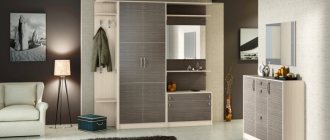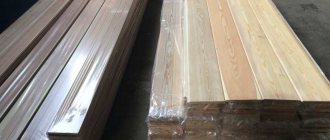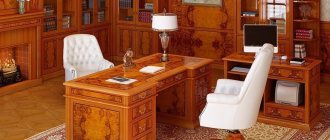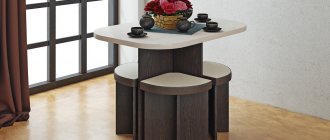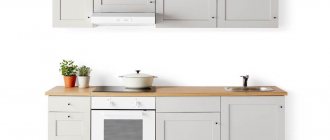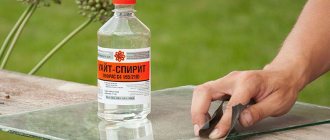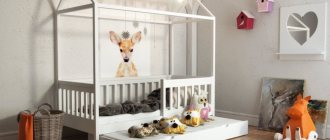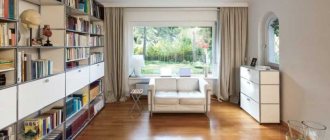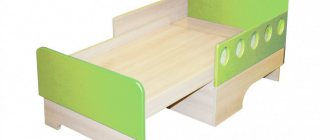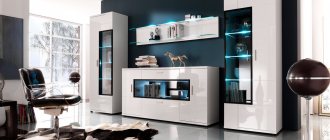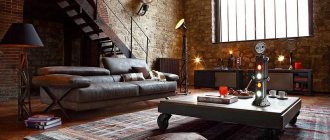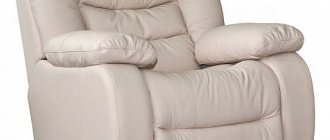Since childhood, we all know and understand what upholstered furniture is and why it is needed. However, when a person comes across the concept of “cabinet furniture,” he often has a question about what exactly belongs to this category and whether there are any exceptions. These and other features will be discussed further.
In general, all furniture can be divided into several large groups:
- case-based – during production it is necessary to have a rigid frame;
- soft – partially or completely with special soft padding for comfortable rest in a sitting or lying position;
- built-in - created to fill niches and individual spaces;
- collapsible and mobile - for quick rearrangement in the room;
- transformer – universal and multifunctional.
What is cabinet furniture
To understand what belongs to cabinet furniture, it is not necessary to read entire manuals; just look at a few pictures to form a general idea. In short, these are products with a rigid frame. It can be either vertical or horizontal. Back walls, external doors, various decorative elements (for example, mirrors or glass), and fittings are subsequently attached to it. Additional walls can be fixed using glue, screws or nails.
In fact, the concept of cabinet furniture is quite broad, and this group includes a large number of models. All of them allow you to create a cozy interior, have sufficient functionality and are often used for storing things or for practical purposes (for studying, cooking, relaxing, working).
Accessories
There are front (handles, locks, legs) and fastening fittings (ties, brackets, hinges, hinges, drawer guides, etc.). There are especially many different fittings in kitchen furniture, where all these hinges, rails, holders, dampers, closers and other contents provide almost half of all consumer properties. It is hardly worth delving into the design features. And yet, we advise you to pay the closest attention to the fittings, since they can serve as a reliable indicator of the quality of furniture . The logic is simple: if a furniture manufacturer used the most primitive and cheap fittings to save money, then where is the guarantee that he did not “save” on the quality of chipboard , on technology, on worker qualifications?
For example, a silumin (aluminum alloy) “corner” screed today already looks suspicious.
Eccentric ties are preferable - they are more accurate and do not catch the eye. On the other hand, such connections require more complex filler equipment. Therefore, furniture assembled on “eccentrics” is most likely of “factory” origin and not of pirated origin. A screw fastener (also known as a “Euroscrew” or “con” cannot be disassembled and reassembled more than two or three times. Threads in the chipboard face no longer live! hinges . In furniture made of chipboard and fiberboard, the use of outdated “piano” hinges is unacceptable - the small screws that secure them will not stay in wood boards for long. Four-hinge hinges are created specifically taking into account this board specificity and are guaranteed to withstand more than 40,000 open/close cycles without the door sagging. However, this only applies to products from well-known, respectable manufacturers. B Recently, a lot of cheap, unscrupulous Chinese-made fittings have appeared in Russia. We do not recommend dealing with them. By what signs can you distinguish good fittings from pirated ones? 1. On a high-quality hinge you can easily find the manufacturer's brand . The most famous among us (in alphabetical order ): Blum, Boward, Ferrari, Grass, Hettich, Lama, Samsung. Many of these companies have their own factories in China and provide strict control over production, so such Chinese products do not arouse suspicion.2. Sure signs of “left-handed” fittings are defects in galvanic coating , uneven color (“discoloration”), large burrs, creaking when opening, incomplete closing of the door. Drawer guides are most often found in two types - roller and ball . They can be easily distinguished by their appearance, and most importantly, by their sound. Roller bearings by their nature have backlash. The balls move smoothly and almost silently. Ball guides are a sure sign of more expensive and solid furniture. Roller drawers have their own advantage: drawers on such guides can easily be completely removed from the cabinet, which is important for office furniture. In recent years, hidden guides, which are used in expensive and high-quality furniture, have become especially popular. These guides are highly reliable: thanks to the built-in dampers, the drawer moves smoothly and closes softly and silently. When buying a cabinet, pay attention to the shelf holders . A cheap detail, a trifle! But it is precisely the attention to detail that demonstrates the manufacturer’s respectful attitude towards both his product and you as a buyer. The simplest shelf holder seems to be durable, time-tested. However, the shelf on it is not fixed securely enough. Today, such shelf holders are used only in the cheapest furniture. Currently, manufacturers of furniture fittings have developed many types of modern shelf holders: for chipboard and glass, hidden, decorative, quick installation, shelf holders-ties, etc. They allow you to make furniture of any design without losing strength and reliability. So, in order not to worry about the furniture you like, you need to study the certificates for it, and then carefully check all the components of its quality in order:
- it is desirable that all surfaces of chipboard or MDF boards be lined;
- Chips, peeling of film or edge material are not allowed on the chipboard and its coating;
- the thickness of the slab on the countertops must be at least 18 mm; the use of a 16 mm slab is not recommended;
- connections of decorative strips (panels, cornices), made at an angle, must be neat, without gaps;
- door hinges must be above suspicion (markings, high-quality coating, no squeaking);
- fasteners - as hidden as possible, hidden inside the slab, or covered with plugs;
- the shelves must be firmly held in place; backlash (swaying of the shelf) indicates the “pirate” origin of the furniture;
- the back walls of the cabinets must be securely fastened; it is desirable that they be made of laminated chipboard or MDF, and not of hardboard (fibreboard) - this reduces the risk that you will accidentally “push” the wall out of the cabinet;
- In the places where the doors adjoin the frame, special pads or dampers must be installed, thanks to which the doors will not rattle when closing.
What materials are cabinet furniture made from?
Furniture manufacturers offer options from various materials that differ in quality, cost and service life. The main ones:
- Furniture board. It is made of wood fiber sheets. Furniture made from this material is characterized by durability, practicality, and resistance to negative factors. It is noteworthy that furniture board is produced without the use of harmful and toxic impurities, which makes it hypoallergenic.
- Chipboard is an inexpensive material based on wood fiber. Quite durable and versatile. Often used for the manufacture of economy-segment furniture or simple models without complex shapes.
- MDF is another fiberboard that is distinguished from chipboard by its greater strength and density. In simple terms, chipboard is glued wood chips, and MDF is glued wood dust. The first is actively used for the manufacture of tables, chests of drawers, wardrobes, and the second is better suited for the manufacture of milled facades or curved furniture.
- Solid wood. One of the best materials for cabinet furniture. It is environmentally friendly and always looks solid and attractive in appearance. Very often the wood used is pine, beech, oak, alder and birch. However, such furniture, with all its advantages, is expensive, so not all buyers can afford it.
Features of choice
It’s not enough to just point to the photo you like and purchase a similar set. You need to approach the issue of choice wisely so that the purchased bed, wardrobe, chest of drawers ideally meets your requirements and the features of the room layout.
Cabinet products include everything except upholstered furniture. We offer you several basic recommendations that will help you make an informed purchase.
- Functionality. Some people put it in first place among the selection criteria, while others pay minimal attention to the issue of functionality. And the latter are wrong here. Practicality plays a huge role, because if the same closet is incredibly beautiful, but lacks the ability to accommodate all your things inside, you will have to look for separate places to store them. But a closet is just a closet to store clothes.
- Workmanship. We have already talked about materials, so be guided by them and your own wallet. Ask the store for documents, certificates, check the quality of not only the main materials, but also fasteners and hooks.
- Dimensions. The choice of the size of the housing elements depends on your needs. If you live alone and have few things, there is no point in buying huge wardrobes. For a large family, it is worth considering the option of large, roomy furniture.
- External characteristics. Having decided on the previous points, now choose based on external data. Just be sure to combine aesthetics with the selection criteria above.
Cabinet furniture is practical, multifunctional and beautiful. All that remains is to choose from the presented assortment, and if you cannot find the ideal option, create it yourself to order.
Modular systems
The essence of the furniture lies in the name itself - it is a set of module blocks that can be easily combined with each other without compromising the design of the room. The modules are stationary, so they can be easily rearranged within the same room and maintain the created style. This type of furniture is equally suitable for a bedroom, a nursery or a teenager’s room.
Modular furniture has two undeniable advantages:
- Low cost. The furniture has an affordable price, and if necessary, you can purchase the missing modules if you see the need. For example, to add a shelving unit to a student’s work area, you just need to purchase a model from the same collection.
- Possibility of various combinations. It is very convenient and practical. Blocks can be easily removed, rearranged, added, and created in various combinations. All this allows you to update your furnishings without additional cash costs.
Custom cabinet furniture
Perhaps the most difficult option for furniture manufacturers and designers. Making furniture to order requires taking measurements in the room, carefully selecting materials and textures. It is also necessary to prepare a design project, thanks to which the customer will be able to evaluate how the furniture he has chosen will look within a particular room. Usually, before confirming an order, 3D layouts are made, where the situation can be seen from all sides. Afterwards, the furniture factory takes the order into production and begins manufacturing the required modules.
Custom-made cabinet furniture is distinguished by its individuality, but at the same time it is extremely expensive.
Classification by functional purpose
1) Storage furniture (cabinet furniture) - designed to accommodate various items
This category includes:
- functional cabinets (bookcases, linen cabinets, clothes cabinets, kitchen cabinets, with a display case, under the sink, buffets, cupboards, wardrobes);
- wall cabinets;
- partition cabinets for dividing rooms into certain zones;
- multi-purpose cabinets that do not have a specific functional purpose. These include: secretaries, sideboard cabinets, chests, cabinets, open and closed shelving, wardrobes.
2) Furniture for lying and sitting:
- beds (single, double, multi-tiered);
- sofas are a combined product designed for sitting (and sofa beds - and lying) for several people;
- couch, ottoman, ottoman;
- banquette;
- stools, chairs, benches;
- armchairs – a category that includes: working chairs, chair-beds, rocking chairs, chaise lounges.
3) Furniture for dining
Furniture for eating and working includes all types of tables:
- dining,
- serving,
- toilet,
- writing,
- the Bureau,
- magazine,
- console,
- desk (student's table),
- music stand,
- dressing table
4) Other products
– this category includes wooden furniture of non-standardized terms, for example, various screens, hangers, etc.
The complete list necessary for cataloging furniture and its certification for certain groups can be found in the All-Russian Classifier of Products (class 56).
What applies to cabinet furniture
Cabinet furniture is often entire series, collections and sets, made in a general style and similar color. As a result, the buyer can take only those models that he really needs to decorate his bedroom, living room, office or nursery.
The concept of “cabinet furniture” includes:
- tables (except for dining and coffee tables);
- chests of drawers and cabinets (except those made from solid wood);
- hinged wardrobes and sliding wardrobes;
- living rooms (with the elements included here: cabinets, hangers, drawers, shelves, chests of drawers);
- hallways;
- furniture for the bedroom (beds, wardrobes, mirrors, chests of drawers, bedside tables);
- furniture for a teenager's or children's room;
- kitchen furniture (sections, wall cabinets, counters, islands);
- all office furniture;
- showcases for shops, pharmacies, dentists, beauty salons.
It is generally accepted that the following do not fall into the category of cabinet furniture: upholstered furniture, glass and coffee tables, chairs, solid furniture (wardrobes, beds, chests of drawers), kitchen corners, antique furniture.
Array
One of the most expensive and environmentally friendly natural materials. It consists of thick panels formed from solid blocks of wood, polished and varnished. The thickness of the shield varies between 2-4 cm. The most commonly used types of wood are coniferous wood, cherry, oak, maple, etc.
Laminate is resistant to scratches and chemicals.
Elite class furniture is made from solid wood. Usually it needs proper care, since natural wood is highly sensitive to temperature changes.
Melamine is characterized by reliability, strength and excellent wear resistance.
